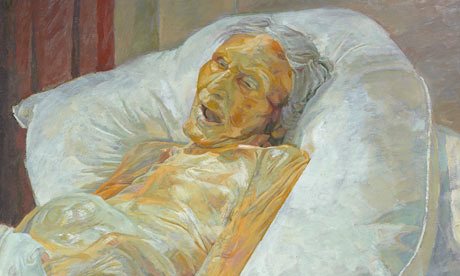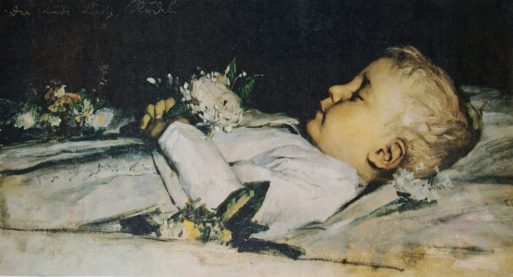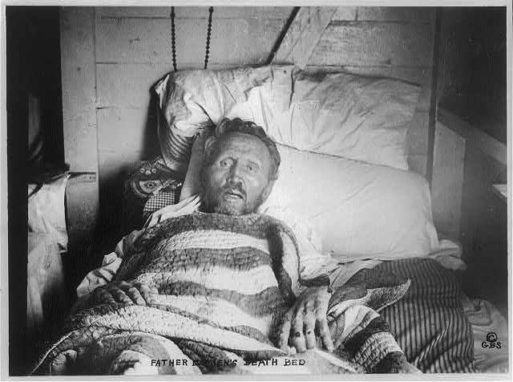In today’s youth-obsessed culture, the twin subjects of aging and death are largely taboo. Although attitudes are changing, many people whose loved ones are dying hold on to the belief that it’s best to remember the person, “as they were in life.” Sadly, this avoidance of the present moment isolates them from the transformative power of actively bearing witness to another’s demise.
In 2010, Daphne Todd took a small step towards breaking this modern convention with her painting, “Last Portrait of My Mother,” a hauntingly beautiful painting of her 100-year-old mother, Annie Mary Todd, following her death. Created over three days in the cold room of a funeral home, the portrait shows her mother’s nude, emaciated body propped up on pillows, a white hospital ID band still on her wrist. Calling it a “devotional study” Todd said of the painting, “I think she looks magnificent.”
The painting earned Todd the 2010 BP Portrait Award and international acclaim.

“Last Portrait of My Mother” by Daphne Todd
(Credit: theguardian.com)
Deathbed portraiture was a common practice during the 18th and 19th centuries, when patrons of the arts would regularly commission portraits of wealthy or powerful individuals following their deaths. Napoleon, Alexander II of Russia and Johann von Goethe are just a few notables whose images were immortalized in this way. When photography became widely available in the mid-1800s, deathbed portraiture experienced a surge in popularity as means of memorializing a loved one who had died. It wasn’t until the early 20th century, when the traditional home funeral was replaced by funeral parlors, undertakers and the embalming of the dead, that the practice became more or less obsolete.

Reudi Anker on his Deathbed, 1869
(Credit: art-now-and-then.blogspot.com)
Some of the most heartrending deathbed portraits are those created by artists who were closely connected to the person who died. Swiss painter Albert Anker’s “Ruedi Anker on his Deathbed,” a deathbed portrait of Anker’s young son, speaks eloquently to the artist’s love for his child and the depth of a parent’s grief.

Father Damien of Molokai
(Credit: wikipedia)
Other portraits are striking in their depiction of the magnificent transition from life into death. For instance, this photograph of Father Damien, the Roman Catholic priest who cared the lepers on the island of Molokai, Hawaii, for 16 years before succumbing to leprosy in April of 1889, was taken shortly before his death. In it, we see the canonized priest staring wide-eyed into the camera, facing death with equanimity and an unflinching acceptance of what is to come. It is a fitting memorial to a man who lived and died in the service to those less fortunate than himself.
Far from morbid or maudlin, deathbed portraiture is a form of homage and remembrance — not just a tribute to those who have died, but a stark reminder that we should each take advantage of this moment to embrace our only opportunity to be fully alive.

 Beautiful Portraits Bear Witness to Death
Beautiful Portraits Bear Witness to Death


 “Summons” by Aurora Levins Morales
“Summons” by Aurora Levins Morales

 AMA Adopts New Policies Expanding Access to Palliative Care
AMA Adopts New Policies Expanding Access to Palliative Care














